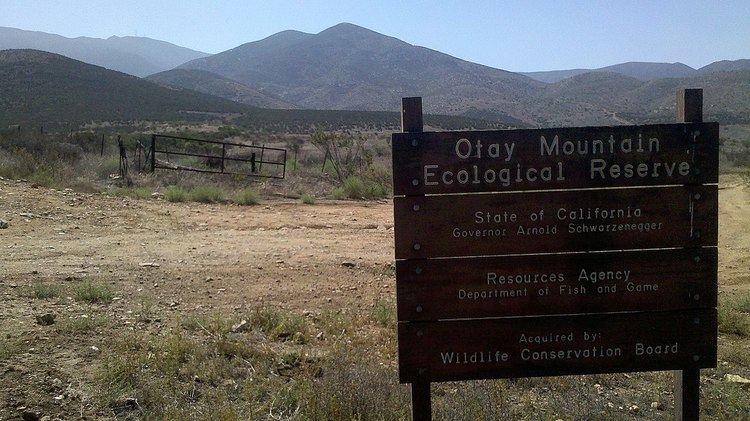Location San Diego County, USA Address Dulzura, CA 91917, USA Established 1999 | Area 68.33 km² | |
 | ||
Governing body Bureau of Land Management | ||
Otay mountain wilderness area
The Otay Mountain Wilderness is a U.S. Wilderness Area located in San Diego County, California, 12 miles east of the city of Otay Mesa and just north of the Mexican border. Some parts of the wilderness area rise quickly from sea level, reaching a peak of just over 3,500 feet (1,100 m) at the summit of Otay Mountain.
Contents
- Otay mountain wilderness area
- Otay mountain wilderness ca
- GeographyEdit
- Natural historyEdit
- FloraEdit
- Endangered speciesEdit
- Rare speciesEdit
- FaunaEdit
- Protected speciesEdit
- Border wall controversyEdit
- References
Wilderness status was conferred on October 7, 1998, effectively preserving 18,500 acres under protection of the Wilderness Act, a component of the National Wilderness Preservation System. The legislation was signed by President Bill Clinton on December 11, 1999.
Otay mountain wilderness ca
GeographyEdit
The Wilderness lies in the San Ysidro Mountains, of which Otay Mountain is the highest summit at 3,566 feet (1,087 m). The mountain, and its immediate surroundings, are extremely rugged and include steep, often precipitous, canyon walls and hills.
The public lands within the Otay Mountain Wilderness are one of the last remaining pristine locations in western San Diego County. Adjacent to the Mexican border, it is internationally known for its diversity of unique and sensitive plants. The area plays a critical role in San Diego's multi-species conservation plan.
Natural historyEdit
The San Ysidro Mountains are remnants of a chain of ancient volcanoes from which meta-volcanic soils form, sustaining a diverse chaparral community dominated by chamise (Adenostoma fasciculatum), mixed chaparral and coastal sagebrush habitats.
FloraEdit
The world's largest stand of Tecate cypress (Cupressus forbesii) are found at Otay Mountain Wilderness, as are at least 15 plant species that are candidates for Federal listing as threatened or endangered species. In all 37 plant species found on Otay Mountain are listed as sensitive by the California Native Plant Society, at least five, including the Tecate cypress, occur only on Otay Mountain or in the immediate are.
Particularly important species include:
Endangered speciesEdit
Rare speciesEdit
FaunaEdit
The diversity of habitats within the Wilderness area maintains a variety of indigenous fauna, including a number of rare or endangered species. The most numerous large animal is the mule deer.
Species of special concern on Otay Mountain include:
Endangered speciesEdit
Protected speciesEdit
Border wall controversyEdit
In the mid 1990s, as part of Operation Gatekeeper, Department of Homeland Security contractors blasted their way through the Otay Mountain Wilderness to erect border walls and associated access roads. The initial phase of wall building extended from San Diego only as far as the foothills of Otay Mountain.
The environmental impact statement carried out prior to the waiver of the law, required to allow construction within the wilderness area, concluded that the works would have long term, adverse impacts on plant, animal and water courses within the area. Grading and construction of roads in the wilderness area would result in removal of valuable layers of topsoil and delicate, intertwined root systems that are essential to protect the dry chaparral habitat from erosion. The wall itself disrupts the ability of migratory animals, like the javelina, to roam freely across its natural range.
It was felt that the mountains themselves posed an overwhelming deterrent to illegal border crossing, and that building the wall within the wilderness area was not necessary. Richard Kite, San Diego Sector spokesman for the Border Patrol stated, in 2006, that
It’s such harsh terrain it's difficult to walk, let alone drive. There's no reason to disrupt the land when the land itself is a physical barrier.
Despite this, in December 2008 work began to continue the wall's progress through the Wilderness area, under the auspices of the Secure Fence Act of 2006.
